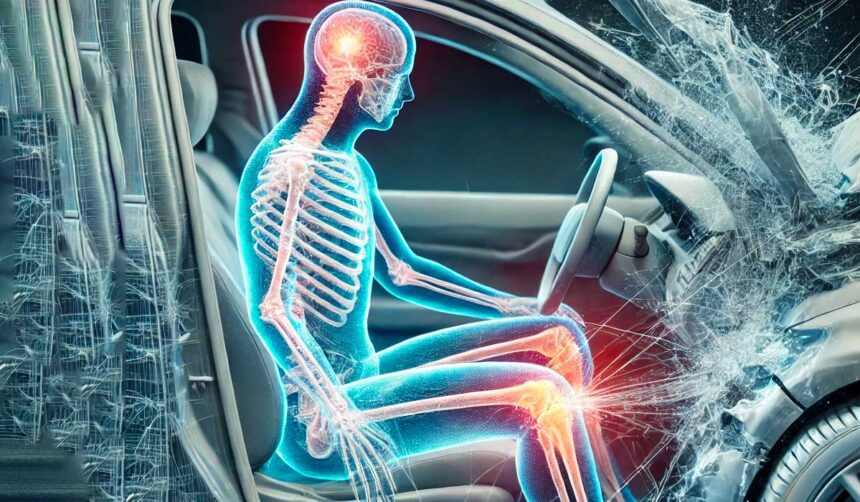Embarking on a journey through the realms of physics and neuromyofascial science, we confront the stark realities of vehicular collisions and their impact on the human body. By equating the speeds of road travel with the terminal velocities of free falls, I invite readers to reassess their understanding of safety, risk, and the forces at play in everyday situations. This discourse is not merely an academic exercise but a crucial reevaluation of how we perceive the act of driving and its potential consequences. As we navigate these insights, we are encouraged to consider the innovative strides in automotive safety and the indispensable value of cautious driving, all through the lens of neuromyofascial science and the undeniable truths of physics.
In other words, how does road speed compare to a fall from a building.
Using newtons laws, we can calculate the speed of a person in an accident and compare to something we are more familiar with; like a fall from height, because most of us have some healthy fear of height.
For example, a 10-foot free fall, or an object dropped from a one-story building, using newtons laws, calculates a terminal velocity or collision speed with the ground of about 17MPH.
The weight of the object makes no difference, so we measure the same terminal velocity or collision speed with the ground whether the object is 10 pounds or 2,000 pounds.
From a 20-foot free fall or drop, which is 2 storeys, the object will be travelling at 24.4 MPH when the ground is struck by the object.
A 30 feet drop or 3 storeys, the object will be travelling at about 30 MPH , which is a a common speed for driving around town to drop the kids off at school.
And finally, a 120-foot drop or 12 storeys, the object reaches a collision speed with the ground of 60 MPH, or a very common speed a car is travelling on a highway in North America, assuming you are not speeding of course.
I believe most listeners are now very surprised about these calculated collision speeds.
So 60 MPH is equal to the speed of a 12 storey fall.
Many may be confused, surprised and even in disbelief about these calculated speeds, and for a few reasons.
The first is that acceleration is ½ x mass weight x velocity squared which greatly affects the calculations of forces of speed.
The second is a psychological process called velocitization, where a passenger or a driver in a car becomes lulled into a sense of moving slower than reality after maintaining a speed over time, such as driving on a highway ay 60 MPH. It really does seems slower over time, but its not.
I got this experience 2 decades ago in Las Vegas when I was in the backseat of a 2 person open wheel race car travelling at 200 MPH. I was not driving.
At first it seemed really fast, but after a few laps, I was ready to drink afternoon tea, as I zoomed around the Las Vegas Speedway.
It was very enlightening, and weird, and that night I had major neck whiplash pain from the G forces caused by the oval turns around the track. Newton was telling me I was going faster than I realized.
The third reason is highway driving at 60 MPH does not offer the same perspective as a free fall, especially with regards to potential injury compared with travelling in a car, versus falling from 120 feet.
The fourth reason is the familiarity of driving in a car, and the perception of safety from riding in a car frequently as most of us do.
The fifth is that many of us, including me, have some degree of a healthy fear from a fall from height.
I can barely climb a ladder 6 steps without some anxiety, yet I drive my car on the highway at 60 MPH and it does not phase me at all, like most everyone else.
So, we all misjudge the risk.
So, it is normal to travel at 60 MPH on a highway, but it is not normal to free fall from 12 storeys, unless you are a parachutist.
However, the terminal speed and deceleration forces of your body are the same, or very similar, in a hard car collision at speed.
Rather sobering thoughts.
To give benefit to auto engineers and physicists, cars today are much safer as they have crumple zones, air bags, seat belts, collision detection, and other special safety technology designed to slow down the rate of deceleration so that your body can better tolerate these sudden deceleration forces.
However, fall from heights do offer some comparable terminal velocities and decelerations as seen in auto collisions.
That is the point I am trying to explain.
We can learn more about assessing injury and rehabilitation requirements by comparing these free fall values as they can offer a more realistic perception of our speed of travel, and a better consideration from everybody concerned for the potential of injury when travelling in a car and encountering an accident.
I commonly state that the human body, if healthy, is able to tolerate a maximum of a 4 MPH collision with minimal injury, which is equivalent to the speed of jogging, or a fall from a few steps.
The human body is not designed to sustain higher forces without injury.
Newtons Law prove that.
In summary, utilizing Newton’s laws to draw parallels between road speed and the impact of a fall from a building unveils some startling realities about the forces we encounter in everyday situations, such as driving. The comparison reveals that the terminal velocities achieved during falls from varying heights can mirror the speeds experienced during vehicle travel, even at what we consider safe, everyday driving speeds. This insight challenges our perceptions, highlighting a general underestimation of the risks associated with common driving speeds due to factors like velocitization and the psychological comfort derived from frequent car use, despite the potential for significant injury in accidents at these speeds.
Reflecting upon the insights garnered from comparing vehicular speeds to the dynamics of free falls, we arrive at a pivotal moment of realization. The forces exerted on the body in a collision, akin to those experienced in a significant fall, illuminate the inherent risks of road travel, often underestimated due to psychological and perceptual factors. This exploration not only broadens our understanding of the neuromyofascial repercussions of such forces but also celebrates the ingenuity behind automotive safety innovations. As we forge ahead, let this knowledge empower us to adopt more prudent driving practices and advocate for continuous advancements in vehicle safety, ultimately safeguarding our well-being in an age defined by mobility and speed.
Medical Disclaimer:
The information provided in this article is for educational and informational purposes only and is not intended as a substitute for professional medical advice, diagnosis, or treatment. Always seek the advice of your physician or another qualified health provider with any questions you may have regarding a medical condition or treatment and before undertaking a new health care regimen, regardless of your location. Never disregard professional medical advice or delay in seeking it because of something you have read on this website.
AI Disclaimer:
The images and abstracts featured in our blog posts are generated using artificial intelligence. While we strive for accuracy and relevance, there may be occasional discrepancies or errors. We appreciate your understanding and encourage readers to consider the context and intent behind these AI-generated elements.




